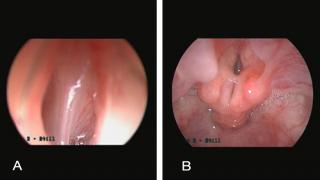It is the rarest and the most serious birth defects of the larynx. It is the result of the incomplete resorption of the epithelial layer that normally fills the lumen of the larynx at the sixth week of development. This epithelial layer is usually eliminated during the tenth week. The involution starts from the dorsal to the ventral side; therefore residual laryngeal membranes are usually anterior, leaving a posterior lumen of varying size. The transmission mode is compatible with an autosomal dominant gene. It can be isolated or part of a malformative syndrome such as the microdeletion of chromosome 22 (see catch-22) et Fraser syndrome (see this term).
There are 3 types of laryngeal atresia (sometimes associated with an eso-tracheal fistula or VACTERL syndrome):
- I: complete atresia , supra - and infraglottic, with absence of vocal cords and median fusion of the arytenoid cartilages .
- II: infraglottic; the vocal cords and the arytenoids are normal but the lumen is obstructed at the level of the cricoid;
- III: a membrane is present at the level of the vocal processes and sometimes accompanied by fusion of the arytenoid cartilages : the glottis is occupied by fibrous tissue. The congenital laryngeal web (see this term) is considered as a minor laryngeal atresia form.
A complete cardiovascular examination needs to be done looking for anomalies of the aortic arch.

Laryngeal membrane: complete
In case of complete obstruction of the laryngeal lumen, the diagnosis, of CHAOS for Complete High Airway Obstruction Syndrome can be made in utero. At birth, the malformation results in acute obstructive respiratory distress once the umbilical cord is clamped. The newborn makes considerable inspiratory efforts but is unable to inhale air or scream. If the lesion was suspected or known, the clamping of the cord must be delayed, if possible, until an emergency tracheostomy is performed to maximize oxygenation of the child (EXIT procedure).
It is important to quickly make the differential diagnosis between laryngeal atresia and agenesis of the trachea as their immediate management at birth is different:
- complete laryngeal atresia: cyanosis with fruitless inspiratory efforts and difficult or impossible ventilation by mask or intubation; mask ventilation is possible only in case of associated esophageal-tracheal fistula; treatment: emergency tracheotomy.
- tracheal agenesis: immediate respiratory distress and lack of cry but possible mask ventilation (except in case of type G); treatment: intubate the esophagus and leave the newborn breathe spontaneously.
When the laryngotracheal lumen is permeable, intubation with a very small probe can allow to wait a few days or weeks before a laryngotracheal repair. Otherwise, the only chance for survival of the child, apart from cases where the laryngeal atresia is incomplete or if there is a upper GI fistula, is the realization of a tracheostomy at birth, which is not always possible (agenesis of the trachea). Mortality in these severe cases remains very high.
Anesthetic implications:
ventilation and/or intubation difficulties ; be prepared to use a laryngeal mask to ventilate and different very small diameter tubes to cross the stenosis (e.g. an ureteral catheter). Emergency tracheostomy.
References
- Garg MK.
Case report: Antenatal diagnosis of congenital high airway obstruction syndrome - laryngeal atresia.
Indian J Radiol Imaging. 2008 ; 18(4):350-1.
- Hoka S, Sato M, Yoshitake J, Kukita J.
Management of a newborn infant with congenital laryngeal atresia.
Anesth Analg 1989; 69: 535-6.
- Shimabukuro F, Sakumoto K, Masamoto H, Asato Y, Yoshida T, Shinhama A, Okubo E, Ishisoko A, Aoki Y.
A case of congenital high airway obstruction syndrome managed by ex utero intrapartum treatment: case report and review of the literature.
Am J Perinatol. 2007; 24:197-201.
- Kohl T, Van de Vondel P, Stressig R, Wartenberg HC, Heep A, Keiner S, Müller A, Franz A, Fröhlich S, Willinek W, Gembruch U.
Percutaneous fetoscopic laser decompression of congenital high airway obstruction syndrome (CHAOS) from laryngeal atresia via a single trocar-current technical constraints and potential solutions for future interventions.
Fetal Diagn Ther 2009; 25:67-71.
- Wyatt ME, Hartley BE.
Laryngotracheal reconstruction in congenital laryngeal webs and atresias.
Otolaryngol Head Neck Surg 2005; 132:232-8.
- Okumus N, Onal EE, Turkyilmaz C, Biri A, Gonul II, Unal S, Poyraz A, Atalay Y.
Resuscitation failure due to Fraser syndrome in a newborn undiagnosed in the prenatal period.
Resuscitation 2005; 65:221-3.
- Soni L, Prasad G, Kaur M.
A case of antenatally undiagnosed laryngeal atresia with tracheoesophageal fistula with airway obstruction at birth and its management.
Pediatr Anesth. 2024;34:175-177.
Updated: January 2024